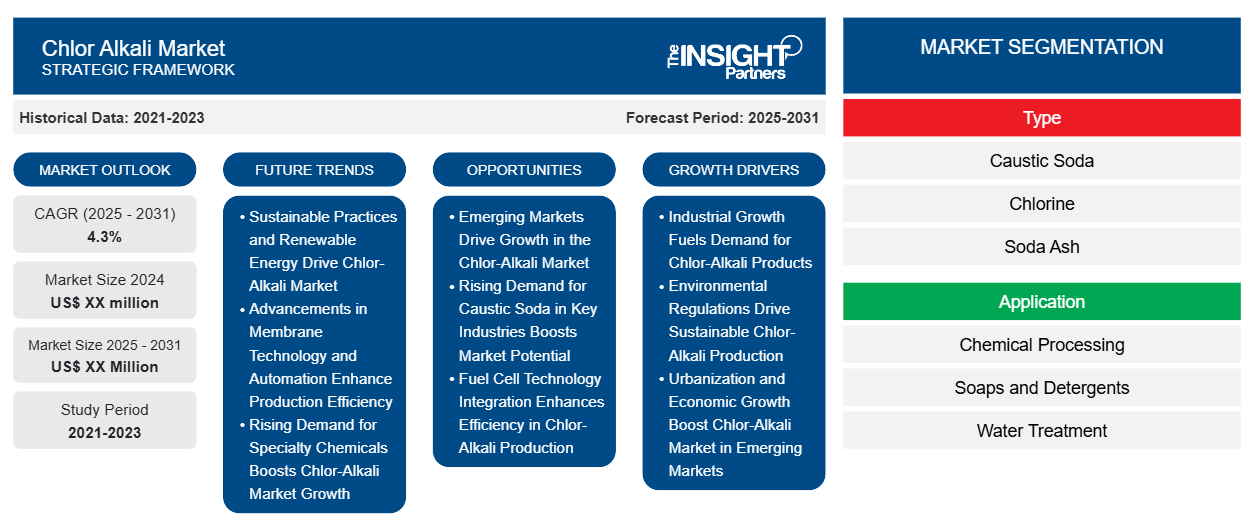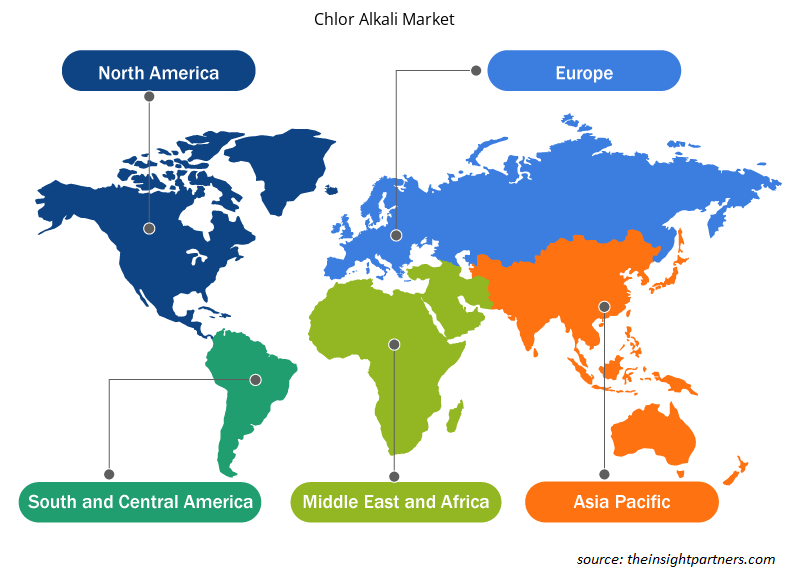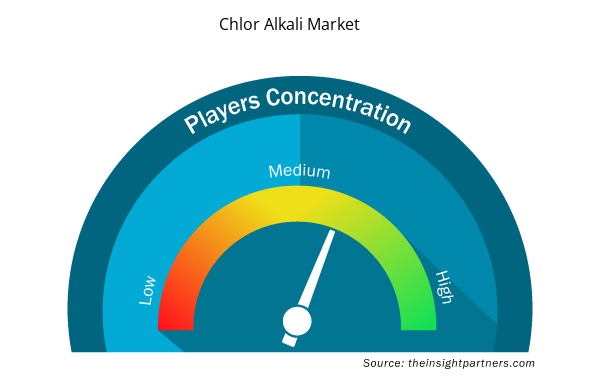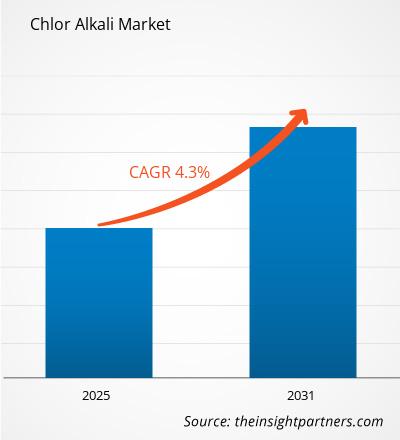Le marché du chlore et de la soude devrait enregistrer un TCAC de 4,3 % de 2025 à 2031, avec une taille de marché passant de XX millions USD en 2024 à XX millions USD d'ici 2031.
Le rapport est segmenté par type de produit (soude caustique, chlore, carbonate de sodium, autres). Le rapport présente en outre une analyse basée sur l'application (traitement chimique, savons et détergents, traitement de l'eau, papier et pâte à papier, textile, transformation des aliments, et autres). Le rapport couvre 5 régions : Amérique du Nord, Europe, Asie-Pacifique, Moyen-Orient et Afrique, Amérique du Sud et centrale et les principaux pays de chaque région. L'analyse globale est ensuite décomposée au niveau régional et par principaux pays. Le rapport offre la valeur en USD pour l'analyse et les segments ci-dessus.
Objectif du rapport
Le rapport Chlor Alkali Market de The Insight Partners vise à décrire le paysage actuel et la croissance future, les principaux facteurs moteurs, les défis et les opportunités. Cela fournira des informations à diverses parties prenantes commerciales, telles que :
- Fournisseurs/fabricants de technologie : pour comprendre l’évolution de la dynamique du marché et connaître les opportunités de croissance potentielles, leur permettant de prendre des décisions stratégiques éclairées.
- Investisseurs : Effectuer une analyse complète des tendances concernant le taux de croissance du marché, les projections financières du marché et les opportunités qui existent tout au long de la chaîne de valeur.
- Organismes de réglementation : Réglementer les politiques et surveiller les activités du marché dans le but de minimiser les abus, de préserver la confiance des investisseurs et de maintenir l’intégrité et la stabilité du marché.
Segmentation du marché du chlore et de la soude
Taper
- Soude caustique
- Chlore
- Cendre de soude
- Autres
Application
- Traitement chimique
- Savons et détergents
- Traitement de l'eau
- Papier et pâte à papier
- Textile
- Transformation des aliments
- Autres
Personnalisez ce rapport en fonction de vos besoins
Vous bénéficierez d'une personnalisation gratuite de n'importe quel rapport, y compris de certaines parties de ce rapport, d'une analyse au niveau des pays, d'un pack de données Excel, ainsi que de superbes offres et réductions pour les start-ups et les universités.
Marché du chlore et de la soude : informations stratégiques

- Obtenez les principales tendances clés du marché de ce rapport.Cet échantillon GRATUIT comprendra une analyse de données, allant des tendances du marché aux estimations et prévisions.
Facteurs de croissance du marché du chlore et de la soude
- La croissance industrielle stimule la demande de produits à base de chlore et de soude caustique : le procédé de fabrication de chlore et de soude caustique permet de produire des produits chimiques importants tels que le chlore et la soude caustique, qui jouent un rôle crucial dans plusieurs industries, notamment celles de la pâte et du papier, du textile et du traitement des eaux. L'industrialisation croissante et le développement des infrastructures alimentent la demande mondiale de ces produits chimiques.
- Les réglementations environnementales favorisent une production durable de chlore-alcali : des réglementations environnementales plus strictes favorisent l'adoption de produits à base de chlore-alcali qui s'alignent sur les objectifs de durabilité. Les progrès des méthodes de production minimisent les émissions et les déchets, ce qui incite les industries à adopter ces options respectueuses de l'environnement, ce qui favorise à son tour la croissance du marché du chlore-alcali.
- L'urbanisation et la croissance économique stimulent le marché du chlore et de la soude dans les marchés émergents : L'urbanisation rapide et la croissance économique dans les marchés émergents stimulent la demande de produits à base de chlore et de soude. Les secteurs en pleine croissance de la construction, de l'automobile et des biens de consommation dans des pays comme l'Inde et le Brésil offrent aux producteurs de chlore et de soude d'importantes opportunités pour renforcer leur présence sur le marché.
Tendances futures du marché du chlore et de la soude
- Les pratiques durables et les énergies renouvelables stimulent le marché du chlore et de la soude : le marché du chlore et de la soude adopte progressivement des pratiques durables en mettant l'accent sur la minimisation de l'empreinte carbone. De nouvelles avancées dans l'électrolyse et l'utilisation de sources d'énergie renouvelables sont introduites, attirant les industries qui recherchent des méthodes de production chimique respectueuses de l'environnement et améliorant la durabilité globale du marché.
- Les progrès de la technologie des membranes et de l'automatisation améliorent l'efficacité de la production : les progrès récents de la technologie des membranes et de l'automatisation augmentent l'efficacité des processus de production de chlore et de soude. Ces améliorations entraînent une baisse des coûts et une augmentation de la production, ce qui rend le marché plus compétitif et plus attractif pour les fabricants qui cherchent à améliorer leurs capacités de production.
- La demande croissante de produits chimiques spécialisés stimule la croissance du marché du chlore et de la soude : La demande croissante de produits chimiques spécialisés, en particulier dans les secteurs pharmaceutique et des soins personnels, propulse le marché du chlore et de la soude. Alors que les industries recherchent du chlore et de la soude caustique de haute pureté pour des applications plus avancées, les fabricants adaptent leurs processus pour répondre à ces exigences particulières.
Opportunités du marché du chlore et de la soude
- Les marchés émergents stimulent la croissance du marché du chlore et de la soude : des pays comme le Brésil, la Chine, l'Afrique du Sud et l'Argentine offrent un potentiel de croissance considérable pour le marché du chlore et de la soude. Le rythme rapide de l'industrialisation et de l'urbanisation dans ces régions stimule la demande de produits chimiques essentiels, permettant aux fabricants d'atteindre de nouveaux clients et de renforcer leur position sur le marché.
- La demande croissante de soude caustique dans des secteurs clés stimule le potentiel du marché : La demande croissante de soude caustique dans divers secteurs tels que le textile, le papier et la transformation des aliments représente une opportunité importante pour les fabricants de chlore-alcali. À mesure que ces industries continuent de croître et d'évoluer, la demande de soude caustique de qualité supérieure stimulera à la fois la production et la croissance des revenus sur le marché.
- L'intégration de la technologie des piles à combustible améliore l'efficacité de la production de chlore et de soude : L'intégration de la technologie des piles à combustible à la production de chlore et de soude offre une opportunité unique. En combinant la production d'hydrogène avec des unités d'alimentation électrique, les fabricants peuvent améliorer l'efficacité énergétique et réduire les coûts d'exploitation, se positionnant ainsi comme leaders de la production chimique durable.
Aperçu régional du marché du chlore et de la soude
Les tendances régionales et les facteurs influençant le marché du chlore et de la soude tout au long de la période de prévision ont été expliqués en détail par les analystes d’Insight Partners. Cette section traite également des segments et de la géographie du marché du chlore et de la soude en Amérique du Nord, en Europe, en Asie-Pacifique, au Moyen-Orient et en Afrique, ainsi qu’en Amérique du Sud et en Amérique centrale.

- Obtenez les données régionales spécifiques pour le marché du chlore et de la soude
Portée du rapport sur le marché du chlore et de la soude
| Attribut de rapport | Détails |
|---|---|
| Taille du marché en 2024 | XX millions de dollars américains |
| Taille du marché d'ici 2031 | XX millions de dollars américains |
| Taux de croissance annuel composé mondial (2025-2031) | 4,3% |
| Données historiques | 2021-2023 |
| Période de prévision | 2025-2031 |
| Segments couverts | Par type
|
| Régions et pays couverts | Amérique du Nord
|
| Leaders du marché et profils d'entreprises clés |
|
Densité des acteurs du marché du chlore et de la soude : comprendre son impact sur la dynamique commerciale
Le marché du chlore et de la soude connaît une croissance rapide, tirée par la demande croissante des utilisateurs finaux en raison de facteurs tels que l'évolution des préférences des consommateurs, les avancées technologiques et une plus grande sensibilisation aux avantages du produit. À mesure que la demande augmente, les entreprises élargissent leurs offres, innovent pour répondre aux besoins des consommateurs et capitalisent sur les tendances émergentes, ce qui alimente davantage la croissance du marché.
La densité des acteurs du marché fait référence à la répartition des entreprises ou des sociétés opérant sur un marché ou un secteur particulier. Elle indique le nombre de concurrents (acteurs du marché) présents sur un espace de marché donné par rapport à sa taille ou à sa valeur marchande totale.
Les principales entreprises opérant sur le marché du chlore et de la soude sont :
- Olin Corporation (États-Unis)
- Solvay SA (Belgique)
- Tata Chemicals Limited (Inde)
- Occidental Petroleum Corporation (États-Unis)
- Axiall Corporation (États-Unis)
Avis de non-responsabilité : les sociétés répertoriées ci-dessus ne sont pas classées dans un ordre particulier.

- Obtenez un aperçu des principaux acteurs du marché du chlore et de la soude
Principaux arguments de vente
- Couverture complète : Le rapport couvre de manière exhaustive l’analyse des produits, des services, des types et des utilisateurs finaux du marché Chlor Alkali, offrant un paysage holistique.
- Analyse d’experts : Le rapport est compilé sur la base d’une compréhension approfondie des experts et analystes du secteur.
- Informations à jour : Le rapport garantit la pertinence commerciale en raison de sa couverture des informations récentes et des tendances des données.
- Options de personnalisation : ce rapport peut être personnalisé pour répondre aux exigences spécifiques du client et s'adapter parfaitement aux stratégies commerciales.
Le rapport de recherche sur le marché du chlore et de la soude peut donc aider à ouvrir la voie au décodage et à la compréhension du scénario de l’industrie et des perspectives de croissance. Bien qu’il puisse y avoir quelques préoccupations valables, les avantages globaux de ce rapport ont tendance à l’emporter sur les inconvénients.
- Analyse historique (2 ans), année de base, prévision (7 ans) avec TCAC
- Analyse PEST et SWO
- Taille du marché Valeur / Volume - Mondial, Régional, Pays
- Industrie et paysage concurrentiel
- Ensemble de données Excel


- Identity Verification Market
- Pharmacovigilance and Drug Safety Software Market
- Legal Case Management Software Market
- Medical Enzyme Technology Market
- Real-Time Location Systems Market
- Adaptive Traffic Control System Market
- Digital Pathology Market
- Joint Pain Injection Market
- Blood Collection Devices Market
- Artwork Management Software Market

Report Coverage
Revenue forecast, Company Analysis, Industry landscape, Growth factors, and Trends

Segment Covered
This text is related
to segments covered.

Regional Scope
North America, Europe, Asia Pacific, Middle East & Africa, South & Central America

Country Scope
This text is related
to country scope.
Questions fréquemment posées
Based on geography, Asia Pacific held the largest share of the chlor alkali market.
The report can be delivered in PDF/Word format, we can also share excel data sheet based on request.
A shift towards greener chemistry is likely to remain the key trend in the market.
Olin Corporation; Solvay S. A.; Tata Chemicals Limited; Occidental Petroleum Corporation; Axiall Corporation; AkzoNobel N. V.; Formosa Plastic Corporation; Hanwha chemical corporation; Tosoh Corporation; and Nirma Limited are among the leading players operating in the chlor alkali market.
Increasing demand for chlor alkali from various end-use industries such as chemicals, paper and pulp, textiles, detergents, among others is driving the market growth.
The Chlor Alkali Market is estimated to witness a CAGR of 4.3% from 2023 to 2031
Trends and growth analysis reports related to Chemicals and Materials : READ MORE..
The List of Companies
1. Olin Corporation (U. S.)
2. Solvay S. A. (Belgium)
3. Tata Chemicals Limited (India)
4. Occidental Petroleum Corporation (U. S)
5. Axiall Corporation (U. S.)
6. AkzoNobel N. V. (Netherlands)
7. Formosa Plastic Corporation (Taiwan)
8. Hanwha chemical corporation (Korea)
9. Tosoh Corporation (Japan)
10. Nirma Limited (India)
The Insight Partners performs research in 4 major stages: Data Collection & Secondary Research, Primary Research, Data Analysis and Data Triangulation & Final Review.
- Data Collection and Secondary Research:
As a market research and consulting firm operating from a decade, we have published and advised several client across the globe. First step for any study will start with an assessment of currently available data and insights from existing reports. Further, historical and current market information is collected from Investor Presentations, Annual Reports, SEC Filings, etc., and other information related to company’s performance and market positioning are gathered from Paid Databases (Factiva, Hoovers, and Reuters) and various other publications available in public domain.
Several associations trade associates, technical forums, institutes, societies and organization are accessed to gain technical as well as market related insights through their publications such as research papers, blogs and press releases related to the studies are referred to get cues about the market. Further, white papers, journals, magazines, and other news articles published in last 3 years are scrutinized and analyzed to understand the current market trends.
- Primary Research:
The primarily interview analysis comprise of data obtained from industry participants interview and answers to survey questions gathered by in-house primary team.
For primary research, interviews are conducted with industry experts/CEOs/Marketing Managers/VPs/Subject Matter Experts from both demand and supply side to get a 360-degree view of the market. The primary team conducts several interviews based on the complexity of the markets to understand the various market trends and dynamics which makes research more credible and precise.
A typical research interview fulfils the following functions:
- Provides first-hand information on the market size, market trends, growth trends, competitive landscape, and outlook
- Validates and strengthens in-house secondary research findings
- Develops the analysis team’s expertise and market understanding
Primary research involves email interactions and telephone interviews for each market, category, segment, and sub-segment across geographies. The participants who typically take part in such a process include, but are not limited to:
- Industry participants: VPs, business development managers, market intelligence managers and national sales managers
- Outside experts: Valuation experts, research analysts and key opinion leaders specializing in the electronics and semiconductor industry.
Below is the breakup of our primary respondents by company, designation, and region:

Once we receive the confirmation from primary research sources or primary respondents, we finalize the base year market estimation and forecast the data as per the macroeconomic and microeconomic factors assessed during data collection.
- Data Analysis:
Once data is validated through both secondary as well as primary respondents, we finalize the market estimations by hypothesis formulation and factor analysis at regional and country level.
- Macro-Economic Factor Analysis:
We analyse macroeconomic indicators such the gross domestic product (GDP), increase in the demand for goods and services across industries, technological advancement, regional economic growth, governmental policies, the influence of COVID-19, PEST analysis, and other aspects. This analysis aids in setting benchmarks for various nations/regions and approximating market splits. Additionally, the general trend of the aforementioned components aid in determining the market's development possibilities.
- Country Level Data:
Various factors that are especially aligned to the country are taken into account to determine the market size for a certain area and country, including the presence of vendors, such as headquarters and offices, the country's GDP, demand patterns, and industry growth. To comprehend the market dynamics for the nation, a number of growth variables, inhibitors, application areas, and current market trends are researched. The aforementioned elements aid in determining the country's overall market's growth potential.
- Company Profile:
The “Table of Contents” is formulated by listing and analyzing more than 25 - 30 companies operating in the market ecosystem across geographies. However, we profile only 10 companies as a standard practice in our syndicate reports. These 10 companies comprise leading, emerging, and regional players. Nonetheless, our analysis is not restricted to the 10 listed companies, we also analyze other companies present in the market to develop a holistic view and understand the prevailing trends. The “Company Profiles” section in the report covers key facts, business description, products & services, financial information, SWOT analysis, and key developments. The financial information presented is extracted from the annual reports and official documents of the publicly listed companies. Upon collecting the information for the sections of respective companies, we verify them via various primary sources and then compile the data in respective company profiles. The company level information helps us in deriving the base number as well as in forecasting the market size.
- Developing Base Number:
Aggregation of sales statistics (2020-2022) and macro-economic factor, and other secondary and primary research insights are utilized to arrive at base number and related market shares for 2022. The data gaps are identified in this step and relevant market data is analyzed, collected from paid primary interviews or databases. On finalizing the base year market size, forecasts are developed on the basis of macro-economic, industry and market growth factors and company level analysis.
- Data Triangulation and Final Review:
The market findings and base year market size calculations are validated from supply as well as demand side. Demand side validations are based on macro-economic factor analysis and benchmarks for respective regions and countries. In case of supply side validations, revenues of major companies are estimated (in case not available) based on industry benchmark, approximate number of employees, product portfolio, and primary interviews revenues are gathered. Further revenue from target product/service segment is assessed to avoid overshooting of market statistics. In case of heavy deviations between supply and demand side values, all thes steps are repeated to achieve synchronization.
We follow an iterative model, wherein we share our research findings with Subject Matter Experts (SME’s) and Key Opinion Leaders (KOLs) until consensus view of the market is not formulated – this model negates any drastic deviation in the opinions of experts. Only validated and universally acceptable research findings are quoted in our reports.
We have important check points that we use to validate our research findings – which we call – data triangulation, where we validate the information, we generate from secondary sources with primary interviews and then we re-validate with our internal data bases and Subject matter experts. This comprehensive model enables us to deliver high quality, reliable data in shortest possible time.

 Obtenez un échantillon gratuit pour ce rapport
Obtenez un échantillon gratuit pour ce rapport